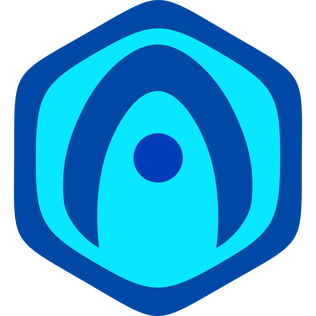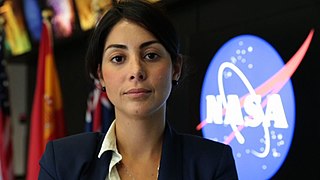Related Research Articles

Jet Propulsion Laboratory (JPL) is a federally funded research and development center in Pasadena, California, United States. Founded in 1936 by Caltech researchers, the laboratory is now owned and sponsored by the National Aeronautics and Space Administration (NASA) and administered and managed by the California Institute of Technology.

2001 Mars Odyssey is a robotic spacecraft orbiting the planet Mars. The project was developed by NASA, and contracted out to Lockheed Martin, with an expected cost for the entire mission of US$297 million. Its mission is to use spectrometers and a thermal imager to detect evidence of past or present water and ice, as well as study the planet's geology and radiation environment. It is hoped that the data Odyssey obtains will help answer the question of whether life existed on Mars and create a risk-assessment of the radiation that future astronauts on Mars might experience. It also acts as a relay for communications between the Curiosity rover, and previously the Mars Exploration Rovers and Phoenix lander, to Earth. The mission was named as a tribute to Arthur C. Clarke, evoking the name of his and Stanley Kubrick's 1968 film 2001: A Space Odyssey.
Maestro (software) was a free program released by NASA to allow users to view photos and daily progress of the Spirit and Opportunity rovers. It served as an activity planner for Mars that utilized a combination of 2D and 3D visuals to track the movement and missions of the Spirit and Opportunity rovers in 2004.
COLLADA is an interchange file format for interactive 3D applications. It is managed by the nonprofit technology consortium, the Khronos Group, and has been adopted by ISO as a publicly available specification, ISO/PAS 17506.

The rocker-bogie system is the suspension arrangement developed in 1988 for use in NASA's Mars rover Sojourner, and which has since become NASA's favored design for rovers. It has been used in the 2003 Mars Exploration Rover mission robots Spirit and Opportunity, on the 2012 Mars Science Laboratory (MSL) mission's rover Curiosity, the Mars 2020 rover Perseverance and ISRO's Chandrayaan-3 rover Pragyan in 2023.
Web3D, also called 3D Web, is a group of technologies to display and navigate websites using 3D computer graphics.
The embedded computer systems onboard Mars rovers are designed to be robust against withstand high radiation levels and large temperature changes in space. For this reason their computational resources are more yet limited compared to systems commonly used on Earth.

WebGL is a JavaScript API for rendering interactive 2D and 3D graphics within any compatible web browser without the use of plug-ins. WebGL is fully integrated with other web standards, allowing GPU-accelerated usage of physics, image processing, and effects in the HTML canvas. WebGL elements can be mixed with other HTML elements and composited with other parts of the page or page background.
NASA has hosted many events for its social media enthusiasts called NASA Socials beginning in 2009. These events are targeted at the social media followers of NASA through platforms such as Twitter, Facebook, Google Plus, Instagram, YouTube and more. They provide guests with VIP access to NASA facilities and speakers with the goal of leveraging participants' social networks to further the outreach requirements of NASA as laid out in the National Aeronautics and Space Act. NASA re-branded these events as "Socials" in March 2012 as it expanded participation to services beyond just Twitter.

Curiosity is a car-sized Mars rover exploring Gale crater and Mount Sharp on Mars as part of NASA's Mars Science Laboratory (MSL) mission. Curiosity was launched from Cape Canaveral (CCAFS) on November 26, 2011, at 15:02:00 UTC and landed on Aeolis Palus inside Gale crater on Mars on August 6, 2012, 05:17:57 UTC. The Bradbury Landing site was less than 2.4 km (1.5 mi) from the center of the rover's touchdown target after a 560 million km (350 million mi) journey.
Blend4Web is a free and open source framework for creating and displaying interactive 3D computer graphics in web browsers.
Anita Sengupta is an American aerospace engineer. She is a graduate in aerospace and mechanical engineering of the Viterbi School of Engineering at the University of Southern California. She was the lead systems engineer of the team that developed the parachute system that was deployed during the landing of Mars Science Laboratory Curiosity. She was subsequently the project manager of the Cold Atom Laboratory at the Jet Propulsion Laboratory at Caltech. She was then the Senior Vice President of Systems Engineering at Virgin Hyperloop One. She is currently Chief Product Officer at Airspace Experience Technologies (ASX).

Kobie Boykins is a senior mechanical engineer at NASA's Jet Propulsion Laboratory in Pasadena, California. In 2013, he was awarded the NASA Exceptional Achievement Medal. He designed the solar array systems for the Mars exploration rovers Spirit and Opportunity, and designed the actuators on the Mars rover Curiosity. He is currently the supervisor of the mobility and remote sensing teams for Curiosity. In 2003, he was part of NASA's M-Team, which lectured nationally to students regarding careers in science, technology, engineering, and mathematics. He lectures internationally for National Geographic regarding exploration on Mars.

glTF is a standard file format for three-dimensional scenes and models. A glTF file uses one of two possible file extensions: .gltf (JSON/ASCII) or .glb (binary). Both .gltf and .glb files may reference external binary and texture resources. Alternatively, both formats may be self-contained by directly embedding binary data buffers. An open standard developed and maintained by the Khronos Group, it supports 3D model geometry, appearance, scene graph hierarchy, and animation. It is intended to be a streamlined, interoperable format for the delivery of 3D assets, while minimizing file size and runtime processing by apps. As such, its creators have described it as the "JPEG of 3D."
OpenXR is an open-source, royalty-free standard for access to virtual reality and augmented reality platforms and devices. It is developed by a working group managed by the Khronos Group consortium. OpenXR was announced by the Khronos Group on February 27, 2017, during GDC 2017. A provisional version of the standard was released on March 18, 2019, to enable developers and implementers to provide feedback on it. On July 29, 2019, OpenXR 1.0 was released to the public by Khronos Group at SIGGRAPH 2019.

Verge3D is a real-time renderer and a toolkit used for creating interactive 3D experiences running on websites.

Lady Diana Trujillo Pomerantz is a Colombian aerospace engineer at the NASA Jet Propulsion Laboratory. She currently leads the engineering team at JPL responsible for the robotic arm of the Perseverance rover. On February 18, 2021, Trujillo hosted the first ever Spanish-language NASA transmission of a planetary landing, for the Perseverance rover landing on Mars.

Sarah Milkovich is lead of Science Operations for the Mars 2020 rover at Jet Propulsion Laboratory. She was investigation scientist for the HiRISE camera on the Mars Reconnaissance Orbiter.
NASA's Eyes Visualization is a freely available suite of computer visualization applications created by the Visualization Technology Applications and Development Team at NASA's Jet Propulsion Laboratory (JPL) to render scientifically accurate views of the planets studied by JPL missions and the spacecraft used in that study. The Eyes family of products is available for desktop computers running Windows 7+, and Mac OSX 10.8+. Deep Space Network Now and Experience Curiosity are web-based and available across all platforms. 3D models of spacecraft and other objects are displayed with the option of comparing their size to a human, school bus, or football stadium.

Vandana "Vandi" Verma is a space roboticist and chief engineer at NASA's Jet Propulsion Laboratory, known for driving the Mars rovers, notably Curiosity and Perseverance, using software including PLEXIL programming technology that she co-wrote and developed.
References
- ↑ "New Online Exploring Tools Bring NASA's Journey to Mars to New Generation". NASA. 5 August 2015. Retrieved 2015-08-07.
- ↑ "Experience Curiosity". NASA's Eyes. Retrieved 2015-08-07.
- ↑ "Prenez le controle de Curiosity avec Blend4Web". Greg G.d.Bénicourt. Archived from the original on 2015-09-19. Retrieved 2015-09-16.
- ↑ "Internet 3D: Take the Curiosity Rover for a Spin Right on the NASA Website". Technology.Org. 11 August 2015. Retrieved 2015-08-12.
- ↑ "Khronos Events - 2015 SIGGRAPH". Khronos. 10 August 2015. Retrieved 2015-08-13.
- ↑ "NASA's Experience Curiosity". Blender.org. Retrieved 2016-02-18.
- ↑ Using the Verge3D as 3D Web Engine is indicated on the official website in Credits in window "About Experience Curiosity"
- ↑ "2016 Webby Award Winner". The Webby Awards. Retrieved 2016-05-18.
- ↑ "NASA Wins Webby Awards". Jet Propulsion Laboratory . Retrieved 2016-07-19.
- ↑ "NASA's 5-Word Speech at the 20th Annual Webby Awards". YouTube . Retrieved 2016-07-19.
